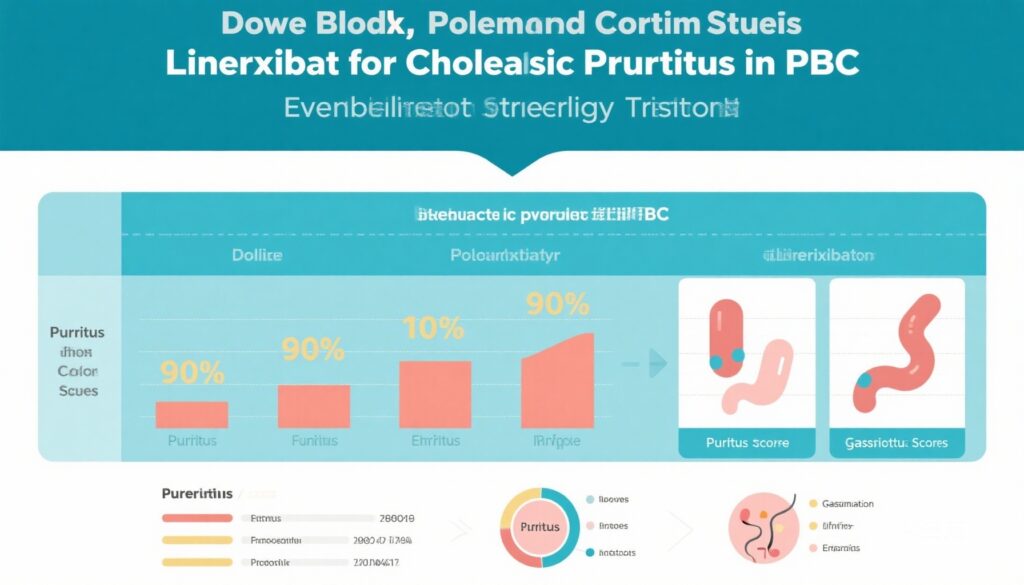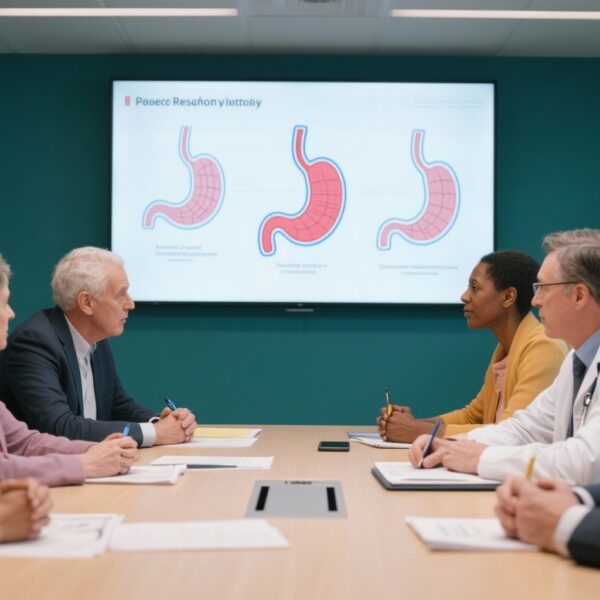Highlights
- Linerixibat, an ileal bile acid transporter (IBAT) inhibitor, significantly reduces moderate-to-severe cholestatic pruritus in PBC patients, as demonstrated by the phase 3 GLISTEN trial.
- Therapeutic benefit correlates with dose-dependent reductions in total serum bile acids and improvement in patient-reported quality of life measures.
- Gastrointestinal adverse events, particularly diarrhea, were frequent but generally manageable; no treatment-related deaths were reported.
- Pruritus severity strongly correlates with impaired sleep, depression, and overall health-related quality of life, underscoring the clinical importance of effective antipruritic therapy in PBC.
Background
Primary biliary cholangitis (PBC) is a chronic autoimmune cholestatic liver disease characterized by progressive destruction of intrahepatic bile ducts, leading to cholestasis and eventual fibrosis. A particularly distressing symptom in up to 70-80% of PBC patients is cholestatic pruritus, which significantly impairs health-related quality of life (HRQoL). Current first-line therapies like ursodeoxycholic acid (UDCA) address liver biochemistry but show limited efficacy for pruritus. Thus, there remains a critical unmet need for targeted antipruritic treatments.
The pathogenesis of cholestatic pruritus is multifactorial. Bile acids (BAs), which accumulate due to impaired biliary secretion, are implicated as pruritogens. The ileal bile acid transporter (IBAT), also known as the apical sodium-dependent bile acid transporter, is responsible for reabsorbing bile acids in the distal ileum, maintaining enterohepatic circulation. Pharmacologic IBAT inhibition offers a novel strategy to reduce systemic bile acid levels and thus alleviate pruritus.
Linerixibat (formerly GSK2330672) is a selective IBAT inhibitor designed for minimal systemic absorption, recently tested across several phases of clinical trials culminating in the phase 3 GLISTEN trial evaluating its efficacy and safety in patients with PBC and moderate-to-severe pruritus.
Key Content
Chronological Development of Evidence for Linerixibat in PBC Pruritus
Early-phase Trials and Mechanism: In phase 1 studies (PMID: 29870578), linerixibat showed favorable pharmacokinetics with minimal systemic exposure and dose-dependent increases in markers of bile acid synthesis (e.g., serum 7α-hydroxy-4-cholesten-3-one [C4]) indicating successful IBAT inhibition. Mild gastrointestinal adverse events, mainly diarrhea, were noted.
A phase 2a crossover trial (PMID: 28187915) involving 22 PBC patients demonstrated that 14-day administration of linerixibat significantly reduced pruritus severity scores (up to 57% decrease) compared with placebo, confirmed by validated itch scales. This trial also documented a 50% reduction in total serum bile acids (TSBA) and a 3-fold increase in serum C4, supporting the pharmacodynamic effect. Diarrhea remained the most frequent adverse event but was generally mild.
Subsequently, the phase 2b GLIMMER trial (PMID: 36343847) explored dose-ranging efficacy across five dosage regimens. Though the primary endpoint failed to reach significance in the intent-to-treat population, post hoc analyses revealed significant dose-response relationships. The 40 mg twice-daily dose demonstrated marked antipruritic effects and favorable tolerability, informing the selection of this regimen for phase 3 evaluation.
The GLISTEN Phase 3 Trial
Design and Population: GLISTEN (NCT04950127) was a large, randomized, double-blind, placebo-controlled, multicenter phase 3 trial enrolling 238 PBC patients with moderate-to-severe pruritus (WI-NRS ≥4) across 115 centers in 19 countries. Patients were randomized 1:1 to oral linerixibat 40 mg twice daily or placebo, stratified by pruritus severity and concomitant pruritus therapy.
Primary Outcome: Change in the Worst Itch Numerical Rating Scale (WI-NRS) over 24 weeks.
Results: Linerixibat significantly improved pruritus, with a least-squares mean reduction from baseline of -2.86 points compared to -2.15 with placebo (adjusted mean difference: -0.72, 95% CI: -1.15 to -0.28; p=0.0013).
Safety Profile: Gastrointestinal side effects were more common in the linerixibat group: diarrhea (61% vs 18% placebo), abdominal pain (18% vs 3%), leading to treatment discontinuation in 7% versus <1% in placebo. Serious adverse events occurred in 12% (linerixibat) versus 3% (placebo), but no deaths were reported.
Correlative Findings and Quality of Life Impact
Data from the GLIMMER study and related analyses highlight profound impacts of pruritus severity on HRQoL. Severe pruritus correlates with lower EQ-5D-5L utility scores, significant depressive symptoms, and marked sleep disturbances (PMID: 39969430, 38862718). Importantly, pruritus reduction with IBAT inhibition was accompanied by improved sleep quality and mood, underscoring the holistic benefit of effective pruritus management.
Pharmacodynamic modeling also revealed that reductions in serum bile acid AUC0-24h correlate with pruritus intensity improvement (PMID: 38780109), suggesting TSBA change as a potential biomarker predicting treatment response.
Ethnic Subgroup and Consistency
The Japanese subgroup analysis of the GLIMMER trial (PMID: 36852705) demonstrated similar efficacy and safety profiles, supporting the generalizability of findings across diverse populations.
Expert Commentary
Linerixibat represents an important pharmacologic advancement for the management of one of the most burdensome symptoms of PBC—cholestatic pruritus—which severely affects quality of life and mental health. The well-conducted, large-scale GLISTEN trial provides robust evidence that targeted IBAT inhibition confers clinically meaningful itch relief sustained over 24 weeks, an improvement over previous symptomatic treatments with limited efficacy or tolerability.
The predominant adverse effect of diarrhea aligns with the drug’s mechanism of interrupting intestinal bile acid reabsorption, which increases bile acid concentration in the colon and accelerates transit. Although some patients may discontinue treatment due to gastrointestinal side effects, the majority tolerate linerixibat with manageable symptoms.
Interestingly, baseline serum bile acid levels do not predict response, whereas on-treatment reductions correlate with symptom relief, indicating this as a useful marker for monitoring efficacy rather than screening.
Clinical guidelines for PBC currently lack specific recommendations for effective antipruritic agents targeting bile acid pathways; the emerging data may inform future guideline updates.
Further research is needed to evaluate long-term safety, impact on liver disease progression, and comparative effectiveness versus other antipruritic treatments.
Conclusion
The accumulated evidence, culminating in the phase 3 GLISTEN trial, establishes linerixibat as a promising and effective targeted therapy for cholestatic pruritus in primary biliary cholangitis. By inhibiting the ileal bile acid transporter, linerixibat reduces systemic bile acid burden, alleviates pruritus, and improves patient quality of life despite expected gastrointestinal side effects. Continued integration of clinical efficacy, patient-reported outcomes, and mechanistic biomarkers will optimize clinical use and guide personalized therapy in PBC-associated pruritus. This novel class of IBAT inhibitors offers a key therapeutic advance in an area of high unmet need within hepatology.



